Telangana TSBIE TS Inter 2nd Year Botany Study Material 1st Lesson Transport in Plants Textbook Questions and Answers.
TS Inter 2nd Year Botany Study Material 1st Lesson Transport in Plants
Very Short Answer Type Questions
Question 1.
What are porins? What role do they play in diffusion? [March 2018]
Answer:
- Porins are proteins that form huge pores in the outer membranes of the plastids, mitochondria and some bacteria.
- Molecules upto the size of small proteins to pass through the channels formed by porins due to facilitated diffusion.
Question 2.
Define water potential. What is the value of water potential of pure water?
Answer:
- Water potential is a relative term, which refers to the chemical potential of pure water to that of chemical potential of water in a solution.
- Water potential of pure water not under pressure is zero (0) at standard temperature.
Question 3.
Differentiate osmosis from diffusion. [March 2017]
Answer:
1. Osmosis :
Movement of water (solvent) from a region of its higher concentration to a region of lower concentration through a selectively permeable membrane, due to pressure and concentration gradient.
2. Diffusion :
Movement of gases and liquids from a region of thejr higher concentration to the region of lower concentration due to concentration gradient.
Question 4.
Compare transpiration and evaporation.
Answer:
- Transpiration is a physiological process, in which water is lost as vapour from the plant surface.
- Evaporation is a physical process, in which water is lost from any free surface in the form of vapour.
Question 5.
What are apoplast and symplast? [March 2019]
Answer:
- Apoplast is the continuous system (network) of cell walls and intercellular spaces in a plant body. This allows movement of water molecules without crossing the cell membranes,
- Symplast is the system of interconnected protoplasts by means of plasmodesmata. This allows movement of water from one cell to another through their cytoplasm.
![]()
Question 6.
How does guttation differ from transpiration?
Answer:
1. Guttations :
The loss of water from the leaves of grasses and many herbaceous plants In liquid form.
2. Transpirations :
The loss of water from the plant surface in the form of vapour.
Question 7.
What happens when a pressure greater than the atmospheric pressure is applied to pure water or a solution?
Answer:
- Water potential increases, if a pressure greater than atmospheric pressure is applied to pure water or a solution.
- It is equivalent to pumping water from one place to another.
Question 8.
Explain what will happen to a plant cell if it is kept in a solution having higher water potential?
Answer:
- Endosmosis occurs when a plant cell is placed in a solution having higher water potential (hypotonic solution)
- Hence, the cytoplasm build up a pressure against the cell wall, which is called turgor pressure.
Question 9.
What are the physical factors responsible for the ascent Of sap through xylem in plants?
Answer:
1. Cohesion :
Mutual attraction between water molecules.
2. Adhesion :
Attraction of water molecules to polar surfaces (such as the surface of tracheary elements)
3. Transpiration pull :
Driving force for upward movement of water.
Question 10.
Explain why xylem transport is unidirectional while that in phloem is bidirectional.
Answer:
- Xylem transport is unidirectional due to one way flow of water in transpiration.
- Food in phloem sap can be transported bidirectionally so long as there is a source of sugar and a sink which is able to use, store or remove the sugar.
Question 11.
With reference to transportation within plant cells, what are source and sink?
Answer:
- Source is understood to be that part of the plant which prepare food i.e., the leaf.
- Sink is the part that needs or store of food i.e., root, stem or fruits.
![]()
Question 12.
Does transpiration occur at night? Give an example.
Answer:
- Yes, transpiration occurs at night is succulent plants (E.g.: Cacti, Bryophyllum)
- Guard cells is those plants become turgid and open at night due to accumulation of organic acids.
Question 13.
Compare the pH of guard cells during the opening and closing of stomata.
Answer:
- The pH of guard cells increases during the opening of stomata due to influx of K+ ions and efflux of H+ ions.
- The pH of guard cells decreases during closing of stomata due to effux of K+ and influx of H+ ions.
Question 14.
In the wake of transpirational loss, why do the C4 plants are more efficient than C3 plants?
Answer:
- C4 plant loses only half as much water as a C3 plant for the same amount of CO2 fixed.
- C4 plants are more efficient than C3 plants in minimizing water loss.
Question 15.
What is meant by transport saturation? How does it influence facilitated diffusion?
Answer:
- Transport saturation : A protein transporters are being used (saturation) and so transport rate reaches maximum.
- During transport saturation all the active sites of carrier proteins are occupied with transporting molecules.
Question 16.
Pressure potential in plant systems can be negative. Elaborate.
Answer:
- Pressure potential in xylem is negative and plays a major role is upward water transport in stem.
- The tension in water column in the xylem is negative (- Ψp) dute to transpirational pull.
![]()
Question 17.
How does ABA bring about the closure of stomata under water stress conditions? [Mar. 2020]
Answer:
- Abscisic acid (ABA) is a natural anti-transpirant.
- This drives the K+ ions out of guard cells under water stress conditions making them close.
Short Answer Type Questions
Question 1.
Define and explain water potential. [Mar. 2019, ’18]
Answer:
Water potential (Ψw) is a relative term to understand water movement. It represents the difference between chemical potential of water in a system and that of a pure water. Water molecules possess kinetic energy. The greater the concentration of water in a system, the greater is its kinetic energy or water potential. Hence, pure water will have greatest water potential. The water potential of pure water at standard temperatures which are not under any pressure, is taken to be zero. Solute potential (Ψs ) and pressure potential (Ψp) are the two main components that determine water potential.
Solute potential :
All solutions have a lower water potential than pure water. The magnitude of this lowering due to dissolution of a solute is called solute potential denoted by Ψs. It is always negative. The more the solute molecules, the lower is the Ψs. For a solution at atmospheric pressure water potential Ψw = solute potential Ψs.
Pressure potential :
The pressure which developed due to entry of water in a cell is called pressure potential. It is always positive, it is denoted as Ψp.
Water potential Ψw of a cell is affected by both solute potential and pressure potential.
Ψw = Ψs + Ψp
Question 2.
Write short notes on facilitated diffusion.
Answer:
- Membrane protein provides sites at which certain molecules can cross the membrane. This process is called facilitated diffusion.
- Porins are proteins that form huge pores in the outer membranes of the plastids, mitochondria and some bacteria, allowing molecules up to the size of small proteins to pass through.
- Concentration gradient must already be present for molecules to diffuse even if facilitated by the proteins.
- In’facilitated diffusion, special proteins help to move substance across the membrane without expenditure of ATP energy.
- Facilitated diffusion cannot cause net transport of molecules from a low to a high concentration this would require input of energy.
- Transport rate reaches a maximum when all of the protein transporters are being used.
- Facilitated diffusion is very specific, it allows cell to select substance for uptake.
- It is sensitive to inhibitors which react with protein side chain.
Question 3.
What is meant by plasmolysis? How is it practically useful to us?
Answer:
Shrinkage of protoplast when the cell is placed in hypertonic solution is called plasmolysis. It occurs when water moves out of the cell and the cell membrane of the cell shrinks away from the cell wall.
The salting of pickles and preserving of fish and meat in salt are good examples of practical application of this phenomenon.
![]()
Question 4.
How does ascent of sap occur in tall trees?
Answer:
In tall trees ascent of sap occurs due to transpiration. It depends mainly on the following physical properties of water.
- Cohesion – mutual attraction between water molecules.
- Adhesion – attraction of water molecules to polar surfaces (such as the surface of tracheary elements)
- Transpiration pull – driving force for upward movement of water.
These properties give water high tensile strength i.e., an ability to resist a pulling force and high capillarity i.e-., the ability to rise in thin tubes.
Photosynthesis needs water and it is supplied by xylem vessels from roots to leaf veins. Transpiration pull is created due to evaporation of water through the stomata.
Question 5.
Stomata are turgor operated valves. Explain.
Answer:
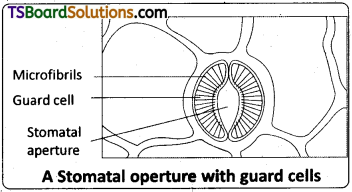
- The cause of opening or closing of the stomata is a change in the turgidity of the guard cells.
- Guard cells are thick towards inner side and thin towards outer side.
- When turgidity increases within the two guard cells, the thin outer walls bulge out and force the inner walls into a crescent shape, stoma opens.
- When the guard cells lose turgor due to water loss (or water stress) the elastic inner walls regain their original shape, the guard cells becomes flaccid and the stoma closes.
Question 6.
Explain pressure flow hypothesis of translocation of sugars in plants.
Answer:
Translocation of sugars from source to sink can be explained by pressure flow or mass flow hypothesis. As glucose is prepared at the source (by photosynthesis) it is converted to sucrose.
The sugar is then moved in the form of sucrose into the companion cells and then into the living phloem sieve tube cells by active transport. This process of loading at the source produces a hypertonic condition in the phloem. Water in the adjacent xylem moves into the phloem by osmosis. it into the energy starch or cellulose. As sugars are removed, the osmotic pressure decreases and water moves out of the phloem and reaches xytem.
This can be shown by following illustration.
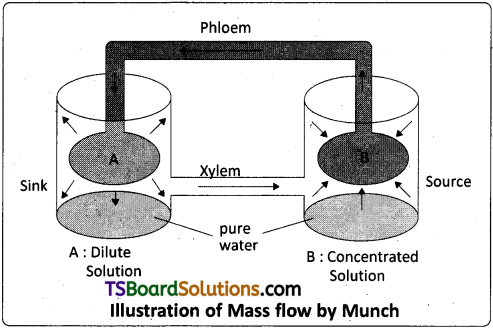
Question 7.
“Transpiration is a necessary evil” – Explain. [Mar. 2020, May, Mar. 2017, ’14]
Answer:
Beneficial and harmful effects of transpiration are below :
Beneficial effects of transpiration :
- It creates transpiration pull for absorption and transportation in plants.
- It supplies water for photosynthesis.
- It transports minerals from the soil to all parts of the plant.
- It cools leaf surfaces, sometimes 10 to 15 degrees, by evaporative cooling.
- It maintains the shape and structure of the plants by keeping cells turgid.
Harmful effects of transpiration :
- Photosynthesis is limited by available water which is depleted by transpiration.
- The humidity of rain forests is largely due to cycling of water from the root to the leaf to the atmosphere and back to the soil.
Even though large amount of water absorbed is lost during transpiration, it is beneficial to plant in many ways. Hence it is considered as “necessary evil”.
Question 8.
A gardener forgot to water a potted plant for a day in summer. What will happen to the plant? Do you think it is reversible? Explain.
Answer:
Plants show wilting.
Yes, it is reversible by watering.
As the potted plant was not water for a day, it will show incipient wilting or temporary wilting. During incipient wilting there is no external symptoms of wilting but the mesophyll cells have lost sufficient water due to transpiration being higher“than the availability of water.
Temporary wilting is the temporary drooping down of leaves and young shoots due to loss of turgidity during noon. It can be corrected only after rate of transpiration decreases accompanied by replenishment of water around root hairs.
Question 9.
Explain the type of molecular movement which is highly selective and requires special membrane proteins, but does not require any metabolic energy.
Answer:
Facilitated diffusion is the type of molecular movement membrane which is highly selective and requires special membrane protein but does not require any metabolic energy.
The random movement of molecules takes place from high concentration to low concentration till equilibrium reaches is called simple diffusion. Membrane provides special proteins to move substances across the membrane by diffusion. This process is called Facilitated diffusion. When all these protein transporters are used transport rate reaches maximum.
Facilitated diffusion is very specific, it allows the cell to select substances for uptake. It is sensitive to inhibitors which react with protein side chain. These special proteins form channels which may be always open or controlled.
Porins are proteins that form huge pores in the outer membranes of the plastids, mitochondria, and some bacteria allowing molecules.
Extra cellular molecules are bound to the transport protein. The transport protein then rotates and releases the molecules inside the cell.
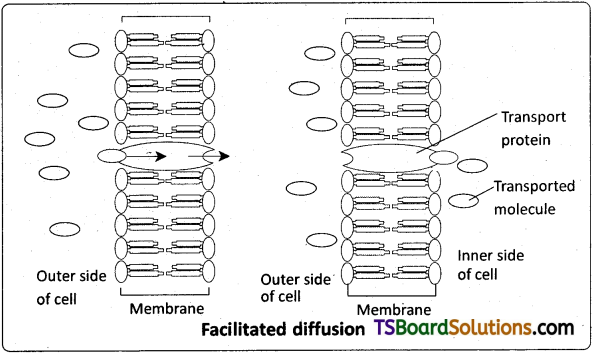
Question 10.
How does most of the water move within a healthy plant body and by which path? [May 2014]
Answer:
Water is absorbed along with mineral solutes by the root hairs purely by diffusion. Once water is absorbed by the root hair, it moves by two distinct path ways.
a) Apoplast pathway
b) Symplast pathway
a) Apoplast pathway :
Apoplast is the continuous system of cell walls and intercellular spaces in plant tissues. In apoplast pathway, water movement is through the cell wall without crossing membranes.
b) Symplast pathway :
Symplast comprises of network of cytoplasm of all cells inter-connected by plasmodesmata. The movement of water occurs from one cell to another through plasmodesmata.
Most of the water flows in the cortex occurs via the apoplast. Since the cortical cells are loosely packed and hence offer no resistance. Endodermis radial walls are thickened with casparian strip. Passage cells allows water by symplast, through pericycle it reaches xylem.
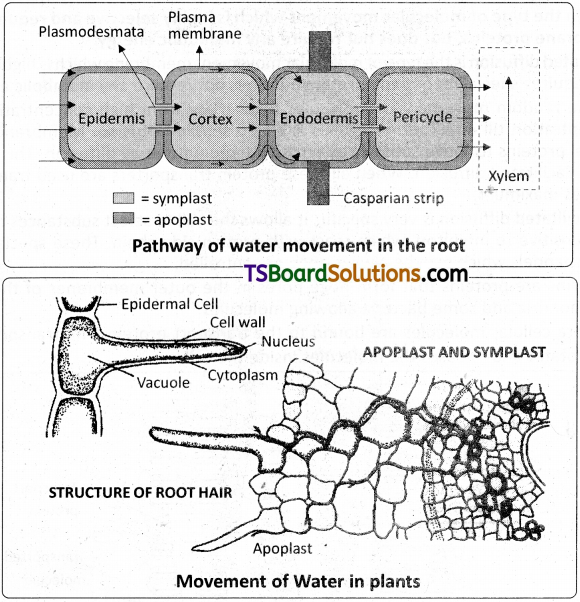
Question 11.
Transpiration and photosynthesis – a compromise. Explain.
Answer:
- Transpiration has more than one purpose : it
a) creates transpiration pull for absorption and transportation in plants.
b) supplies water for photosynthesis.
c) transports minerals from the soil to ail parts of the plant.
d) cools leaf surfaces, sometimes 10 to 15 degrees, by evaporative cooling.
e) maintains the shape and structure of the plants by keeping cells turgid. - An actively photosynthesising plant has an insatiable need for water.
- Photosynthesis is limited by available water which can be swifty depleted by transpiration.
![]()
Question 12.
Do different species of plants growing in the same area show the same rate of transpiration at a particular time? Justify your answer.
Answer:
No. Different species of plant growing in the same area does not show the same rate of transpiration at a particular time. Plants take up huge amount of water daily but most of it is lost to the air through evaporation from the leaves he., transpiration.
A mature corn plant absorbs almost three litres of water in a day while a mustard plant absorbs water equal to its own weight in about 5 hours.
Long Answer Type Questions
Question 1.
Explain how plants absorb water.
Answer:
Water is absorbed along with mineral solutes by the root hairs purely by diffusion. Once water is absorbed by the root hair, it moves by two distinct pathways.
a) Apoplast pathway
b) Symplast pathway
a) Apoplast pathway :
it is “the system of adjacent cell walls that is continuous throughout plant, except at the casparian strips of endodermis in roots.” Apoplastic movement of water takes place through intercellular spaces and cell walls. Movement through apoplast does not include crossing cell membrane. It is dependent on the gradient. It does not provide any barrier to water movement. The water movement is through mass flow. When the water evaporates into intercellular spaces or atmosphere, a tension develops in continuous stream of water in apoplast. Therefore mass flow of water takes place as a result of adhesive and cohesive properties of water.
b) Symplast system :
It is “the system of interconnected protoplasts.” The adjacent cells are connected through cytoplasmic strands that extend through plasmodesmata. In it, water travels through the cells – their cytoplasm; intercellular movement is through plasmodesmata. Water enters the cells only through the cell membrane, so the movement is relatively slower. The movement is again down a potential gradient. It may cytoplasmic streaming.
Most of the water flow in roots takes place by apoplast as cortical cells are loosely packed. They offer no resistance to water movement. Endodermis is impervious to water due to casparian strip. Water moves through symplast and again crosses a membrane to reach the cells of the xylem. In the endodermis, the movement of water is symplastic. This is the only way water and other solutes can enter the vascular cylinder.
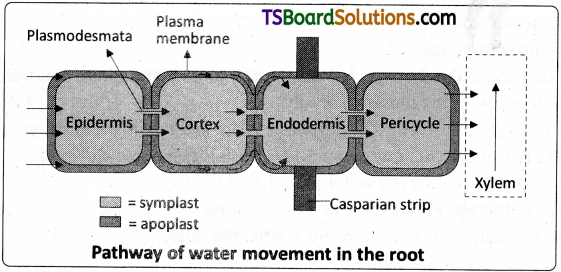
Question 2.
Define transpiration. Explain the structure and mechanism of opening and closing of stomata.
Answer:
Transpiration is defined as the loss of water in the form of vapour from the living tissues of aerial parts of the plants.
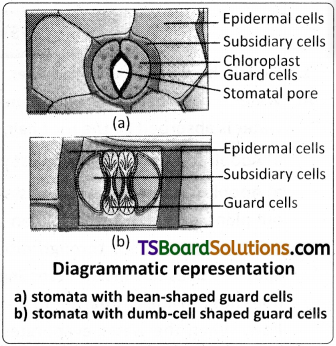
Structure of Stomata :
Each stoma is composed of two bean shaped cells known as guard cells. In grasses, the guard cells are dumb-bell shaped. The outer walls of guard cells are thin and inner walls are thickened. The guard cells possess chloroplasts and regulate the opening and closing of stomata. Sometimes, a few epidermal cells, in the vicinity of the guard cells become specialised in their shape and size and are known as subsidiary cells. The stomatal aperture, guard cells and the surrounding subsidiary cells are together called stomatal apparatus.
Opening and closing of stomata :
The stoma is the turgor operated valve in the epidermis.
- The immediate cause of opening or closing of the stomata is a change in the turgidity of the guard cells.
- The inner wall of each guard cell towards the pore or stomatal aperture is thick and elastic.
- When turgidity increases within the two guard cells flanking each stomatal aperture or pore, the thin outer walls bulge out and force the inner walls into a crescent shape,
- The opening of the stoma is also aided by the orientation of the microfibrils in the cell walls of the guard cells.
- Cellulose microfibrils are oriented radially rather than longitudinally, making it easier for the stoma to open.
- When the guard cells lose turgor due to water loss the elastic inner walls regain their original shape, the guard cells becomes flaccid and the stoma closes.
Levitt proposed K+ pump theory to explain the mechanism of opening and closing of photoactive stomata.
Opening of stomata :
- According to this theory accumulation of K+ ions into the guard cells from the subsidiary cells occurs in the presence of light.
- This coupled with efflux of protons leads to increase in pH of the guard cells.
- Accumulation of K+ ions into the guard cells is associated with passive influx of Cl– ions thereby decreasing the water potential of the guard cells.
- Water thereby enters the guard cells making them turgid.
- As the outer walls are thin and elastic, the guard cells expand outwardly, leaving a minute pore at the centre open.
Closing of stomata :
- At night, in the absence of light, the K+ and Cl– ions move out of the guard cells due to which the water potential of guard cells increases and water starts moving out of them leading to closure of stomata.
- Under water stress conditions, abscisic acid (ABA) a natural anti-transpirant drives the K+ ions out of guard cells making them close.
- In Succulent plants, the water potential gradient established due to accumulation of organic acids at night makes the guard cells become turgid, hence stomata opens at night.
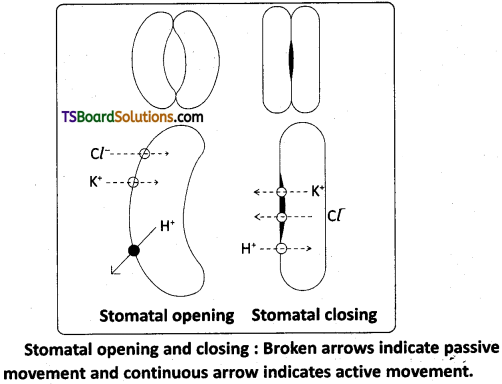
Intext Question Answers
Question 1.
Differentiate uphill and downhill transport.
Answer:
Active transport uses energy to pump molecules against a concentration gradient. That means from a low concentration to a high concentration. It is called uphill.
Passive transport does not use energy. It transport from high concentration to low concentration. It is called downhill.
![]()
Question 2.
Compare facilitated diffusion and simple diffusion.
Answer:
The random movement of individual molecules from a region of higher concentration to a region of lower concentration is called simple diffusion. Facilitated diffusion is a type of molecular movement which is highly selective and required special membrane proteins. These proteins form channels in the membrane for molecules to pass through. These channels may be open always or controlled.
Question 3.
What happens when two solutions of different concentrations are separated by egg membrane? State the reason.
Answer:
When two solutions of different concentrations are separated by egg membrane osmosis takes place. Osmosis occurs spontaneously in response to a driving force. The net direction and rate of osmosis depends on both the pressure gradient and concentration gradient.
Question 4.
Compare imbibing capacities of pea and wheat seeds.
Answer:
Proteins have a very high imbibing capacities followed by starch and cellulose the least. That is why proteinaceous pea seeds swell move on imbibition than starchy wheat seeds.
Question 5.
In general in a plant which path of water movement is more and why?
Answer:
Major proportion of water flow in the root cortex occurs via the apoplast since the cortical cells are loosely packed and hence offer no resistance to water movement. However, the inner boundary of the cortex, the endodermis, is impervious to water because of a band of suberised matrix called the casparian strip. Water flow is by symplast, through pericycle and ultimately reaches xylem.
Question 6.
Why do Pinus seeds fail to germinate in the absence of mycorrhiza?
Answer:
A mycorrhizae is a symbiotic association of a fungus with a root system. The fungus provides minerals and water to the roots, in turn the roots provide sugars and N – containing compounds to the mycorrhizae. Some plants have an obligate association with the mycorrhizae. So pinus seeds fail to germinate in the absence of mycorrhizae.
Question 7.
Which structures do you think the Pinus plant does not possess due to which its seeds fail to germinate?
Answer:
Mycorrhizae.
Question 8.
What do you think is the driving force for ascent of sap?
Answer:
Transpiration pull.
Question 9.
Why do stomata close under water stress conditions?
Answer:
Under water stress conditions, abscisic acid (ABA) a natural anti-transpirant drives the K+ ions out of guard cells making them close.
Question 10.
How are stomata distributed in a typical monocot plant?
Answer:
Stomata are distributed .equally, both in upper epidermis and lower epidermis in typical monocot plant.
Question 11.
In what form the sugars are transported through phloem?
Answer:
Sucrose
Question 12.
The inward movement of water into a plant begins either as symplast or apoplast. How does it conclude before entering into xylem?
Answer:
Symplast
Question 13.
Why does the root endodermis transports ions in one direction only?
Answer:
Endodermis have casparian strips on their radial walls. Hence the movement of water through the root layers is symplastic in endodermis. This is the only way water and other solutes can enter vascular cylinder. So in endodermis transportation of ions occurs in one direction.
Question 14.
If a ring of bark is removed from an actively growing plant, what will happen and why?
Answer:
In the absence of downward movement of food the portion of the bark above the ring on the stem becomes swollen after a few weeks. This shows that phloem is the tissue responsible for translocation of food and that transport takes place in one direction i.e., towards the roots.
![]()
Question 15.
A flowering plant is planted in an earthen pot and watered. Urea is added to make the plant grow faster, but after some time the plant dies. Why?
Answer:
As urea is added the concentration of water in the pot increases. Instead of root hairs absorbing water, the water in the plant comes out due to exosmosis. The cells get plasmolyzed. After some time the plant dies.